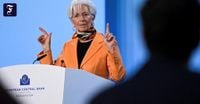The European Central Bank (ECB) has made a significant move in its monetary policy by lowering interest rates for the seventh time since June 2024. On Thursday, April 17, 2025, the ECB announced a reduction of the deposit rate by 0.25 percentage points, bringing it down to 2.25 percent. This decision reflects the ongoing challenges facing the Eurozone economy, particularly in light of the trade disputes initiated by the United States, which have raised concerns about a possible global recession.
The interest rate cut aims to stimulate weak economic growth within the Eurozone, particularly in Germany, where economic forecasts have been downgraded due to the trade tensions. The ECB's move is designed to make borrowing cheaper for both consumers and businesses, encouraging investment at a time when economic activity is sluggish. "The economy of the Eurozone has built up a certain resilience to global shocks, but growth prospects have been clouded by increasing trade tensions," the ECB stated in its announcement.
ECB President Christine Lagarde emphasized the need for European unity in response to the challenges posed by tariffs imposed by the U.S. administration. "We are in an existential moment for Europe," Lagarde said, urging Europeans to embark on a "march towards independence" from external pressures. Her comments reflect a growing sentiment among European leaders to reduce reliance on the United States amid escalating trade disputes.
The inflation rate in the Eurozone has shown signs of easing, dropping to 2.2 percent in March from 2.3 percent in February. This decline in inflation provides the ECB with more room to maneuver its monetary policy, allowing for further interest rate cuts if necessary. Experts anticipate at least one more reduction in the near future, with many banks expecting the deposit rate to fall to around 2 percent or even lower.
However, the impact of the interest rate cut on savers is not favorable. As banks receive lower rates for their deposits with the ECB, they are likely to pass these reductions onto consumers. According to the financial comparison portal Verivox, average interest rates for savings accounts are currently at 1.4 percent, with fixed deposit rates for two-year terms averaging just 2.11 percent, the lowest level since December 2022.
Market analysts have noted that the current environment of low interest rates is expected to persist, which could lead to further declines in savings returns. Oliver Maier, managing director of Verivox, indicated that the downward trend in savings rates is likely to continue as banks adjust to the new monetary landscape. "In the past weeks, overnight deposit rates have continued their downward trajectory almost unabated," Maier remarked.
While the ECB's rate cuts aim to stimulate economic activity, the overall economic growth in the Eurozone remains precarious. The economy grew by only 0.2 percent in the final quarter of 2024, and recent surveys have indicated a slight uptick in activity, particularly in the industrial and service sectors. However, the ongoing trade war and the uncertainty surrounding U.S. tariffs pose significant risks to the recovery.
The trade war, initiated by former President Donald Trump, has transformed economic forecasts and created a climate of uncertainty that dampens consumer and business confidence. Economists warn that if tariffs remain in place for an extended period, they could hinder economic growth not only in the Eurozone but also in key export nations like Germany and Italy.
The ECB has acknowledged the challenges posed by Trump's tariff policies, stating that the increased uncertainty is likely to diminish confidence among households and businesses. Michael Heise, a former chief economist at Allianz, noted that the extraordinary level of uncertainty is impacting global trade and economic growth. "The uncertainty caused by the tariff dispute dampens overall economic demand," Heise explained.
In addition to the impact on growth, the trade war has also affected commodity prices. The price of oil has fallen by approximately 17 percent since the announcement of tariffs, which, alongside the strengthening euro, is contributing to a decrease in inflationary pressures. The euro has appreciated by about 5 percent against the dollar since the tariffs were introduced, making imports cheaper for Eurozone consumers.
As the ECB navigates these turbulent waters, it remains committed to monitoring economic indicators closely. The central bank has indicated that its monetary policy decisions will depend on the evolving data landscape, with adjustments made from meeting to meeting. This approach reflects the uncertainty surrounding the global economic environment and the potential for further adjustments in response to changing conditions.
Looking ahead, the ECB will continue to face challenges as it strives to balance the need for economic stimulus with the risks posed by external factors. The upcoming interest rate decision on June 5, 2025, will be closely watched by market participants, as it could provide further insights into the ECB's response to ongoing economic pressures.
In summary, the ECB's recent interest rate cut is a strategic move aimed at supporting the Eurozone's fragile economic recovery amidst rising trade tensions and declining inflation. While it offers potential benefits for borrowers, savers are likely to feel the pinch as interest rates continue to decline. The situation remains fluid, and the ECB's future decisions will depend heavily on the evolving economic landscape.








